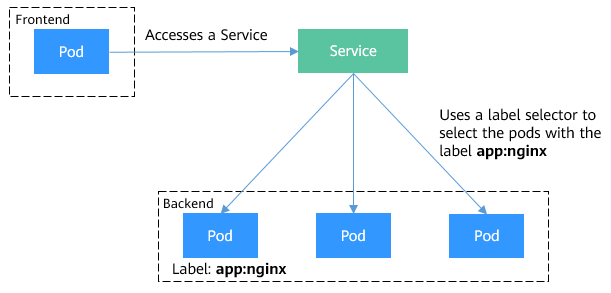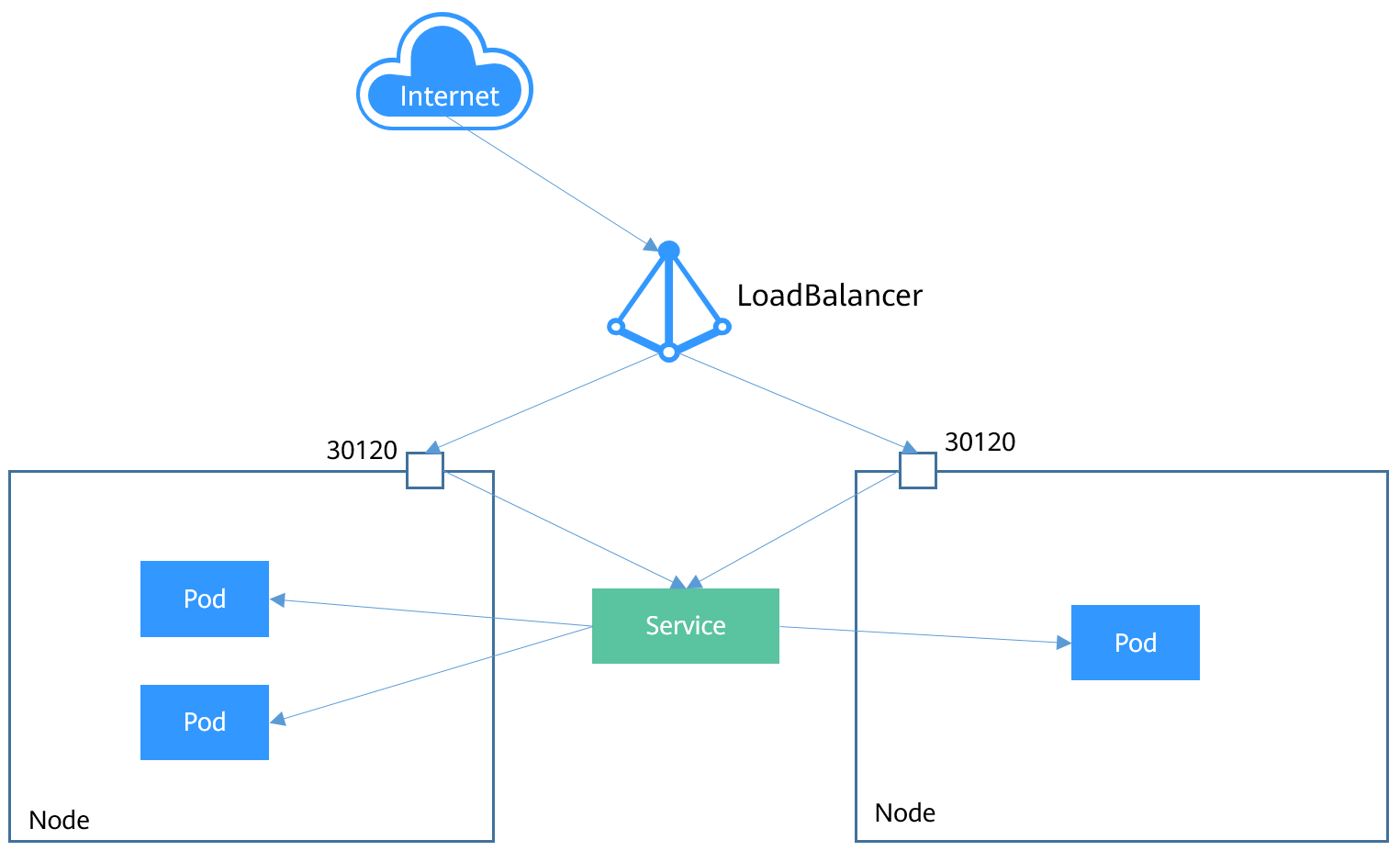04 network
1. Service Types and Application Scenarios
Services of the ClusterIP, NodePort, LoadBalancer, and Headless Service types offer different functions.
- ClusterIP: used to make the Service only reachable within a cluster.
- NodePort: used for access from outside a cluster. A NodePort Service is accessed through the port on the node. For details, see NodePort Services.
- LoadBalancer: used for access from outside a cluster. It is an extension of NodePort, to which a load balancer routes, and external systems only need to access the load balancer. For details, see LoadBalancer Services.
- Headless Service: used by pods to discover each other. No separate cluster IP address will be allocated to this type of Service, and the cluster will not balance loads or perform routing for it. You can create a headless Service by setting the spec.clusterIP value to None. For details, see Headless Services.
we can use kubectl expose command setting this, And we can setting use console also.
| # When using the NodePort type, the port here is meaningless. When accessing through a node, you need to actually view the corresponding NodePort.
# This port parameter is only use for internal access when set the nodeport
kubectl expose deployment deployment-name --port=30080 --target-port=80 --name=service-name --type=NodePort
kubectl expose --type=NodePort deployment nginx --port 80 --name nginx-nodeport --overrides '{ "apiVersion": "v1","spec":{"ports": [{"port":80,"protocol":"TCP","targetPort":80,"nodePort":30080}]}}'
kubectl expose deployment deployment-name --port=80 --target-port=80 --name=service-name --type=ClusterIP
kubectl expose deployment hello-world --port 80 --type=LoadBalancer
# we can create a service and modify the selector
kubectl create service nodeport myservice --node-port=31000 --tcp=3000:80
|
Manage clusters via console or commands
We can see the Cluster Information → Resources → Connection Information → kubectl, And then get the more details informations about configure kubectl.


When we finished all the steps, we can use commands operate the CCE cluster:
| [root@ecs-c5e5 ~]# kubectl get ns
NAME STATUS AGE
default Active 32h
kube-node-lease Active 32h
kube-public Active 32h
kube-system Active 32h
|
Kubectl autocomplete
| [root@ecs-c5e5 ~]# yum -y install bash-completion
[root@ecs-c5e5 ~]# source <(kubectl completion bash)
[root@ecs-c5e5 ~]# echo "source <(kubectl completion bash)" >> ~/.bashrc
|
You can also use a shorthand alias for kubectl that also works with completion:
| alias k=kubectl
complete -o default -F __start_kubectl k
|
ClusterIP
1
2
3
4
5
6
7
8
9
10
11
12
13
14
15
16
17
18
19
20
21
22
23
24 | [root@ecs-c5e5 ~]# kubectl apply -f nginx.yaml -f tomcat.yaml
deployment.apps/nginx created
deployment.apps/tomcat created
[root@ecs-c5e5 ~]# kubectl expose deployment nginx --type=ClusterIP --name=nginx-service --port=80 --target-port=80
service/nginx-service exposed
[root@ecs-c5e5 ~]#
[root@ecs-c5e5 ~]# kubectl get pods -o wide
NAME READY STATUS RESTARTS AGE IP NODE NOMINATED NODE READINESS GATES
nginx-698c667dd7-zrnrx 1/1 Running 0 2m8s 172.16.0.13 192.168.34.211 <none> <none>
tomcat-77b6db4bdd-x295j 1/1 Running 0 2m8s 172.16.0.12 192.168.34.211 <none> <none>
[root@ecs-c5e5 ~]# kubectl get svc -o wide
NAME TYPE CLUSTER-IP EXTERNAL-IP PORT(S) AGE SELECTOR
kubernetes ClusterIP 10.247.0.1 <none> 443/TCP 33h <none>
nginx-service ClusterIP 10.247.156.240 <none> 80:80/TCP 36s app=nginx
[root@ecs-c5e5 ~]# kubectl get endpoints
NAME ENDPOINTS AGE
kubernetes 192.168.34.240:5444 33h
nginx-service 172.16.0.13:80 49s
[root@ecs-c5e5 ~]# kubectl scale deployment nginx --replicas=2
deployment.apps/nginx scaled
[root@ecs-c5e5 ~]# kubectl get endpoints
NAME ENDPOINTS AGE
kubernetes 192.168.34.240:5444 33h
nginx-service 172.16.0.13:80,172.16.0.14:80 64s
|
Access test like this:
1
2
3
4
5
6
7
8
9
10
11
12
13
14
15
16
17
18
19
20
21
22
23
24
25
26
27
28
29
30
31
32
33
34
35
36
37
38
39
40
41
42
43
44
45
46
47
48
49
50
51
52
53
54
55
56
57
58
59
60
61
62
63
64
65
66
67
68
69
70
71
72
73
74
75
76
77
78
79
80
81
82
83
84
85
86
87
88
89
90
91
92
93
94
95
96
97
98
99
100
101
102
103
104
105
106
107
108
109
110 | [root@ecs-c5e5 ~]# kubectl exec -it tomcat-77b6db4bdd-x295j -- /bin/bash
root@tomcat-77b6db4bdd-x295j:/usr/local/tomcat#
# Access USE Pod IP
root@tomcat-77b6db4bdd-x295j:/usr/local/tomcat# curl 172.16.0.13
<!DOCTYPE html>
<html>
<head>
<title>Welcome to nginx!</title>
<style>
html { color-scheme: light dark; }
body { width: 35em; margin: 0 auto;
font-family: Tahoma, Verdana, Arial, sans-serif; }
</style>
</head>
<body>
<h1>Welcome to nginx!</h1>
<p>If you see this page, the nginx web server is successfully installed and
working. Further configuration is required.</p>
<p>For online documentation and support please refer to
<a href="http://nginx.org/">nginx.org</a>.<br/>
Commercial support is available at
<a href="http://nginx.com/">nginx.com</a>.</p>
<p><em>Thank you for using nginx.</em></p>
</body>
</html>
# Access use ClusterIP
root@tomcat-77b6db4bdd-x295j:/usr/local/tomcat# curl 10.247.156.240
<!DOCTYPE html>
<html>
<head>
<title>Welcome to nginx!</title>
<style>
html { color-scheme: light dark; }
body { width: 35em; margin: 0 auto;
font-family: Tahoma, Verdana, Arial, sans-serif; }
</style>
</head>
<body>
<h1>Welcome to nginx!</h1>
<p>If you see this page, the nginx web server is successfully installed and
working. Further configuration is required.</p>
<p>For online documentation and support please refer to
<a href="http://nginx.org/">nginx.org</a>.<br/>
Commercial support is available at
<a href="http://nginx.com/">nginx.com</a>.</p>
<p><em>Thank you for using nginx.</em></p>
</body>
</html>
# Access use service name
root@tomcat-77b6db4bdd-x295j:/usr/local/tomcat# curl nginx-service
<!DOCTYPE html>
<html>
<head>
<title>Welcome to nginx!</title>
<style>
html { color-scheme: light dark; }
body { width: 35em; margin: 0 auto;
font-family: Tahoma, Verdana, Arial, sans-serif; }
</style>
</head>
<body>
<h1>Welcome to nginx!</h1>
<p>If you see this page, the nginx web server is successfully installed and
working. Further configuration is required.</p>
<p>For online documentation and support please refer to
<a href="http://nginx.org/">nginx.org</a>.<br/>
Commercial support is available at
<a href="http://nginx.com/">nginx.com</a>.</p>
<p><em>Thank you for using nginx.</em></p>
</body>
</html>
# Access use Domain
root@tomcat-77b6db4bdd-x295j:/usr/local/tomcat# cat /etc/resolv.conf
search default.svc.cluster.local svc.cluster.local cluster.local
nameserver 10.247.3.10
options ndots:5 timeout:2 single-request-reopen
root@tomcat-77b6db4bdd-x295j:/usr/local/tomcat# curl nginx-service.default.svc.cluster.local
<!DOCTYPE html>
<html>
<head>
<title>Welcome to nginx!</title>
<style>
html { color-scheme: light dark; }
body { width: 35em; margin: 0 auto;
font-family: Tahoma, Verdana, Arial, sans-serif; }
</style>
</head>
<body>
<h1>Welcome to nginx!</h1>
<p>If you see this page, the nginx web server is successfully installed and
working. Further configuration is required.</p>
<p>For online documentation and support please refer to
<a href="http://nginx.org/">nginx.org</a>.<br/>
Commercial support is available at
<a href="http://nginx.com/">nginx.com</a>.</p>
<p><em>Thank you for using nginx.</em></p>
</body>
</html>
|
nodeport

1
2
3
4
5
6
7
8
9
10
11
12
13
14
15
16
17
18
19
20
21
22
23
24
25
26
27
28
29
30
31 | [root@ecs-c5e5 ~]# kubectl get svc nginx-service -o yaml
apiVersion: v1
kind: Service
metadata:
creationTimestamp: "2023-08-27T05:13:44Z"
labels:
app: nginx
name: nginx-service
namespace: default
resourceVersion: "86260"
uid: fac3c03a-fb5d-4341-812f-cff661c9ebe2
spec:
clusterIP: 10.247.156.240
clusterIPs:
- 10.247.156.240
externalTrafficPolicy: Cluster
internalTrafficPolicy: Cluster
ipFamilies:
- IPv4
ipFamilyPolicy: SingleStack
ports:
- nodePort: 31428
port: 80
protocol: TCP
targetPort: 80
selector:
app: nginx
sessionAffinity: None
type: NodePort
status:
loadBalancer: {}
|
loadbalancer

1
2
3
4
5
6
7
8
9
10
11
12
13
14
15
16
17
18
19
20
21
22
23
24
25
26
27
28
29
30
31
32
33
34
35
36
37
38
39
40
41
42
43
44
45
46
47
48
49
50
51
52
53
54 | [root@ecs-c5e5 ~]# kubectl get service
NAME TYPE CLUSTER-IP EXTERNAL-IP PORT(S) AGE
kubernetes ClusterIP 10.247.0.1 <none> 443/TCP 47h
nginx ClusterIP 10.247.80.80 <none> 80/TCP 13h
nginx-elb LoadBalancer 10.247.155.17 110.238.103.45,192.168.34.190 80:32337/TCP 3m24s
nginx-node NodePort 10.247.183.147 <none> 30080:32180/TCP 13h
[root@ecs-c5e5 ~]# kubectl get svc nginx-elb -o yaml
apiVersion: v1
kind: Service
metadata:
annotations:
kubernetes.io/elb.autocreate: '{"name":"elb-test","type":"public","bandwidth_name":"cce-bandwidth-1693163374519","bandwidth_chargemode":"traffic","bandwidth_size":5,"bandwidth_sharetype":"PER","eip_type":"5_bgp"}'
kubernetes.io/elb.class: union
kubernetes.io/elb.eip-id: fba071e4-58aa-407a-bf00-4f5fc28cd73d
kubernetes.io/elb.health-check-flag: "on"
kubernetes.io/elb.health-check-option: '{"protocol":"TCP","delay":"5","timeout":"10","max_retries":"3"}'
kubernetes.io/elb.id: a68106b8-f754-4369-8618-af21e8143dc3
kubernetes.io/elb.lb-algorithm: ROUND_ROBIN
kubernetes.io/elb.mark: "0"
creationTimestamp: "2023-08-27T19:10:37Z"
finalizers:
- service.kubernetes.io/load-balancer-cleanup
labels:
app: nginx
name: nginx-elb
namespace: default
resourceVersion: "119775"
uid: 53191067-b9aa-4cc3-84df-ec4d5cbada74
spec:
allocateLoadBalancerNodePorts: true
clusterIP: 10.247.155.17
clusterIPs:
- 10.247.155.17
externalTrafficPolicy: Cluster
internalTrafficPolicy: Cluster
ipFamilies:
- IPv4
ipFamilyPolicy: SingleStack
loadBalancerIP: 110.238.103.45
ports:
- name: cce-service-0
nodePort: 32337
port: 80
protocol: TCP
targetPort: 80
selector:
app: nginx
sessionAffinity: None
type: LoadBalancer
status:
loadBalancer:
ingress:
- ip: 110.238.103.45
- ip: 192.168.34.190
|
loadbalancer
service
2. ELB Ingress & Nginx Ingress
ELB Ingress

Access use the domain:

Nginx Ingress
Install the nginx-ingress plug-in and create a policy:

Because we didnot have the domain, so we can add the hosts record to verify. we need add the DNS A record if we have a real domain.
1
2
3
4
5
6
7
8
9
10
11
12
13
14
15
16
17
18
19
20
21
22
23
24
25
26
27
28
29
30
31
32
33
34
35
36
37
38
39
40 | [root@ecs-c5e5 ~]# cat /etc/hosts
::1 localhost localhost.localdomain localhost6 localhost6.localdomain6
127.0.0.1 localhost localhost.localdomain localhost4 localhost4.localdomain4
127.0.0.1 ecs-c5e5 ecs-c5e5
110.238.103.45 www.abc.com
110.238.103.45 java.abc.com
[root@ecs-c5e5 ~]# curl -I java.abc.com
HTTP/1.1 200
Date: Mon, 28 Aug 2023 11:41:41 GMT
Content-Type: text/html;charset=UTF-8
Content-Length: 3084
Connection: keep-alive
Last-Modified: Mon, 28 Aug 2023 01:01:15 GMT
Accept-Ranges: bytes
Content-Language: en-US
[root@ecs-c5e5 ~]# curl www.abc.com
<!DOCTYPE html>
<html>
<head>
<title>Welcome to nginx!</title>
<style>
html { color-scheme: light dark; }
body { width: 35em; margin: 0 auto;
font-family: Tahoma, Verdana, Arial, sans-serif; }
</style>
</head>
<body>
<h1>Welcome to nginx!</h1>
<p>If you see this page, the nginx web server is successfully installed and
working. Further configuration is required.</p>
<p>For online documentation and support please refer to
<a href="http://nginx.org/">nginx.org</a>.<br/>
Commercial support is available at
<a href="http://nginx.com/">nginx.com</a>.</p>
<p><em>Thank you for using nginx.</em></p>
</body>
</html>
|
Ingress
捐赠本站(Donate)

如您感觉文章有用,可扫码捐赠本站!(If the article useful, you can scan the QR code to donate))







